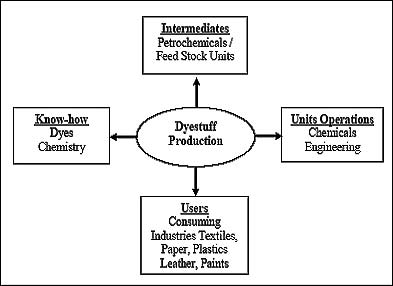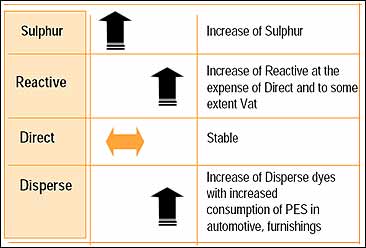A multibillion dollar industry that consists of
Dyes, Pigments and Intermediates.
In Global Dyestuff industry, an impressive growth has been seen over the
years. This industry includes three sub-segments namely Dyes, Pigments, and
Intermediates. The dye intermediates are essential derivatives of petroleum
products which after further processing gets transformed into finished dyes
and pigments.
The dye and dye intermediaries industry is now an integral part of a huge
number of industries. Be it chemical, of which it has a substantial stake,
along with that it also provides inputs to a large number of other major
industries like textiles, leather, plastics, paints, paper and printing
inks, pharmaceuticals to name a few. The following diagram highlights how
the Dyestuff industry's interconnection with other facets of the industrial
setup:

In 2005, the global market size for dyes, pigments and intermediaries was
estimated at around $23 billion. If we see the total volume, then global
dyestuff production is estimated to be somewhere around 34 million tonnes.
The annual global sales of textile dyestuff alone is estimated approximately
around $ 6 billion. One of the major factors that had emerged within the
last few years is that the major production centres for dyestuff has shifted
from the west to the east. The global dye manufacturing industry originally
dominated by suppliers from Europe namely UK, Switzerland Germany, has
shifted to Asia over the past 20 years or so. This is primarily because of
two reasons. First, due to much lower costs of production in the Asia
region. Secondly Asia's growing prominence as the hub for global textile
industry.
The markets for the dyes are predominantly dominated by reactive and
disperse dyes. In fact the demand for these two dyes is expected to grow in
future also. Nations like China, South Korea and Taiwan are strong players
in the field of disperse dyes. Interestingly, India has taken lead in
production of reactive dyes because of the availability of an intermediate
called vinyl sulphone in the country. The following diagram illustrates the
expected trends of some of the prominent dyes.

China's share in the world market is estimated to be around 25%. Along with
China, Taiwan, India, Japan and Pakistan are among the major dyestuff
producing countries in the industry. But in terms of the sheer volume of
market share, Europe is the leading. This is due because of its allegiance
towards specialty products. The global market share of Indian dyes industry
is between 5 - 7%, and it is continuously increasing year by year.
Though an impressive growth has been seen in
Global Dyestuff Industry, but still this industry is facing some serious
challenges. And these challenges are:
Environmental Considerations- The thrust is now towards the
environment friendly natural dyes. The industry can only prosper if the dyes
are not hazardous and environment friendly. A very good example is the
banning of the Azo dyes in Europe along with closure of the units.
Support of the Government and Trade Association- Any industry that
moves ahead needs the back-end support of the government as well as the
trade associations. This helps to promote that industry in other countries,
allocation of investments and giving other supports. These associations
should actively promote technology institutes that does research activities.
Problem of over capacity but falling margins- It is a fact that
China and India now have high potential as regards production capacity is
concerned. This is due to a shift in the manufacturing bases from Europe and
some other industrialise nations. But there is varying demand across these
regions and that is the cause for volatility in the market. Thus affecting
prices.
Fierce competition- Again, because of the shift of companies from
West to East has resulted in concentration of all the companies in the Asian
region which has created intense competition in the global market.
Research & Development- Market demands a higher spending for
innovation in products like natural dyes.
Product quality vis-a-vis competitive prices- Manufacturers should
focus on the quality of products along with competitive prices for retaining
market. The production share of the developed countries in the market has
gone down from 65% to around 50% and this is further expected to reduce in
future.
Classification of products and services- A decline in the growth for
products has prompted the manufacturers to move to specialty products.
High cost of energy and interest- The exorbitant cost of interest
can lower the investment in R&D which is at the core of product and
service innovations. Also, the high energy cost has also adversely impacted
the manufacturing units.
Availability of World Class Infrastructure- As ports and roads are
the primary sources of transport, the Governments must emphasis to improve
the clearance of the goods at a quicker rate to facilitate trade.

![]() Profile
Profile ![]() Product Range
Product Range![]() Industries
Industries![]() Infrastructure
Infrastructure![]() Our Quality
Our Quality![]() Custom Manufacturing
Custom Manufacturing![]() Network
Network![]() Contact Us
Contact Us![]() Send Enquiry
Send Enquiry




![]() Profile
Profile
![]() Product
Range
Product
Range![]() Industries
Industries![]() Infrastructure
Infrastructure![]() Our
Quality
Our
Quality![]() Custom
Manufacturing
Custom
Manufacturing![]() Network
Network![]() Contact
Us
Contact
Us![]() Send
Enquiry
Send
Enquiry